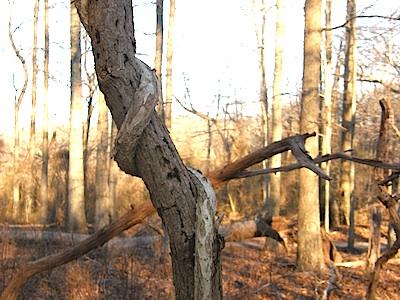Nature Notes: Round and Round

An authority on rope suggested to me that vines that climb up trees go up clockwise just as the first course of rope is laid in its manufacture. Do all vines go “right-handed,” like rope? Of course, a right-handed vine is only right-handed when looking up from the ground. Looking down from its top it is left-handed or counterclockwise.
I also wondered if the rule might apply to trees. Forty years ago when teaching college in Oregon I noticed that many Oregon conifers, in particular Douglas firs and true firs, spiral up as they grow. Their trunks are twisted and the twist is always to the right. Such twisting of the grain is often hidden by the bark, which appears to go straight up, but is readily seen once the bark is removed.
In the Northern Hemisphere, the sun after rising in the east arcs to the south then swings back to the west, where it sets. The growing tip of a vine, or apical meristem, that is following the sun as it grows upward would circle the tree in a counterclockwise direction. Right-handed vines, or twisty tree trunks, would not be chasing the sun.
Then there is the Coriolis effect, which when applied on a grand scale is responsible for the Gulf Stream moving to the right as it courses northward in the Atlantic Ocean from the eastern tropics to the coast of Ireland. Because a vine rotating around a tree trunk is so small in scale compared to a current in the Atlantic Ocean, it is doubtful that vining is a function of the Coriolis effect.
On Monday I went looking for curling vines and twisty tree trunks in the Morton Wildlife Refuge in Noyac. There were several woody vining species, or lianas, to observe — wild grape, poison ivy, Japanese honeysuckle, Virginia creeper, and Asiatic bittersweet among them. This last species was by far the most common and so I was able to make a statistical study of its curling habits.
I looked at more than 100 bittersweet vines in a half-mile of trail, all of which went up the tree in a clockwise rotation. In some instances there were three different bittersweet vines curling around each other, all of which were right-handed or clockwise. A few wild grapes circled upward in the same fashion, but the majority of them were opportunistic, taking the most straightforward route to get to the top. Wild grapes have tendrils, little curlicues that fasten onto tree branches to help them climb.
Poison ivy, like the unrelated Boston ivy and Virginia creeper, has holdfasts resembling the round suction-disc toes of tree frogs to give it purchase on tree trunks. It goes straight up. Bittersweet is like a snake. It has no special tree-climbing appendages, thus to get purchase it has to “strangle” its host, and some literally do just that, frequently leading to the host tree’s death by cutting off the flow of nourishments and water up and down in the conductive tissues lying just beneath the bark. Bittersweet vines are cross-ribbed, giving them extra holding power.
Except for a black cherry or two, the twisted-trunk trees were Juniperus virginiana, eastern red cedar, one of the evergreen conifers native to Long Island. Roughly 5 percent of the hundreds of junipers covering the refuge had twisted trunks and, as in the bittersweets, all were twisting clockwise. I was beginning to think that all vines and trunks that twist as they go upward were right-handed.
The adaptive value of the bittersweet twist was obvious, but what was the function of twisting in the junipers? Many arborists and foresters believe that a twisted trunk makes a tree stronger and better able to withstand gale-force winds. To test that hypothesis on the eastern red cedars, I examined trunks in quiet stands well away from the edge of Peconic Bay and those along its edge, where winds were expected to hit with more force. The outcome? The percentage of twisted trunks in the quiet groves was just as high as along the shore.
At the end of the walk, along the edges of the Morton Wildlife Refuge parking lot a stone’s throw from Noyac Road, I encountered patches of Japanese honeysuckle. Lo and behold, their vines were all left-handed, turning counterclockwise as they climbed. Thus, at least in Noyac, not all vining species are right-handed.
Monday night I visited the Web and read about an amazing woman botanist, Angela Moles from Australia, who went around the world studying vines and their climbing habits. She studied 1,485 vines of several different species. Ninety-four percent of them were left-handed. In other words, the main reason for one vine’s penchant for curling one way and another’s for moving in the exact opposite direction is primarily genetic.
With respect to trees, the preponderance of twisted trees is found among the coniferales. In fact, a cultivar of one oriental species, Juniperus chinensis torulosa, is always twisted. Perhaps that’s why it’s known in American horticultural circles as the Hollywood juniper. But for almost every conifer species that exhibits twisting, say, the bristle-cone pine of the Western mountain ranges, the most venerable of all trees, left-handedness and right-handedness is as it is in the human species — there are both left-handed and right-handed individuals. Whether it is genetic or environmental in the bristle-cone has yet to be determined.
But the question begs an easy solution. Take seeds from left-handed and right-handed bristle-cones, plant them and record their development, a process that could take 50 years or so. These long-lived trees are extremely slow growing.
